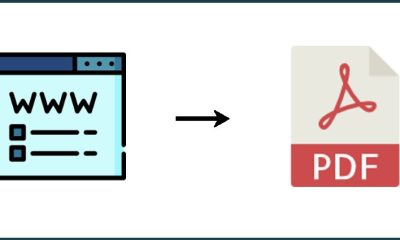Career Tips
Steps On How To Make A Resume Website

When looking for a job, the internet is an invaluable resource. It may assist you in connecting with professionals, discovering new possibilities, developing new abilities, and more. One approach to use the internet when applying for jobs is to showcase your experience to others, such as through a resume website. In this post, we will define a resume website, detail how to develop one, examine some of the benefits of these websites, and provide some recommendations to assist you in creating one.
What is a resume website?
A resume website is a professional website where you can discuss your experience and interests. It also allows you to include a biography to introduce yourself or a portfolio to demonstrate your value as a professional. While any sort of professional can use this format, it may be especially useful for professionals like:
- Actors
- Freelancers
- Models
- Musicians
- Photographers
- Sound engineers
- Videographers
- Writers
There are various strategies to use when creating a resume website, such as:
Creating pages for each section
Using this strategy leads in a more detailed website. This may include developing a homepage with a brief introduction to who you are, what you’re searching for, and what general experience you have. Following that, you may construct specific pages to further debate subjects such as:
- Achievements
- Education
- Experience
- Skills
While not required, you may include a page to further explore your hobbies or personal interests if you want to showcase more of your personality on your website. Make sure to use consistent formatting across all pages, and search for opportunities to incorporate relevant links to firms you worked for or projects you completed. It’s also crucial to have a page with your basic contact information so that hiring managers can reach you. Organize your pages into a simple, user-friendly menu so that hiring managers may easily traverse your website.
Linking from a landing page
Using a landing page, you can construct a basic single webpage with buttons that allow readers to download your resume in PDF format and contact you. This may be useful if you have a well-written CV that you are pleased of and want a simple way to submit it online. It also offers hiring managers a user-friendly interface and a file format that they are familiar with and can readily exchange.
This method could be more challenging to optimize for search engines. This may impede job supervisors from locating your resume as readily. To tackle this issue, consider using industry-related talents and keywords in your landing page biography. Search engines may scan and locate these, allowing hiring managers to find your resume.
Making a multimedia timeline
Choosing this option allows you to construct a single webpage outlining your employment history. Similar to a standard resume, it lists your work history in reverse chronological order and contains details about your responsibilities and accomplishments at each employment. It may also have graphic components throughout. For example, you might include an infographic that depicts your accomplishments, or you could build and publish a short portfolio of work you did at each employment.
This may be the most challenging method to select. When creating your website, make sure it has a consistent appearance, that all information is correctly structured, and that there is a means to reach you. The end result might be a detailed and interactive resume that engages and thrills the user about your skills.
How to make a resume website
1. Select a method
Determine the strategy you want to utilize to build your resume website. Consider which option best fits your tastes, experience, professional field, and skills. For example, if you want a simple way to post your resume online, constructing a landing page may be ideal for you. Alternatively, if you want to develop a website that serves as both your resume and portfolio, creating many pages or a detailed timeline may be a smart idea.
2. Research platforms
Look at platforms that allow you to build webpages. While employing a builder may incur a modest price, the majority of these platforms provide tools and services that make the website construction process easier for you. For example, these platforms may help you register your domain name, provide web hosting services, and provide templates that you can use and alter. When researching your alternatives, make sure to select a platform that allows you to develop a website using your preferred manner.
3. Choose a template
After you’ve chosen your platform and completed the registration procedure, you can start developing your website. Browse the templates available and choose the one that best suits your method and aesthetic preferences. Customize the template by altering the colors or rearranging the elements on each page. Most systems provide drag-and-drop capabilities that, regardless of your web development skill level, allow you to simply design your website.
4. Create your pages
Add more pages to your website. Each page should serve a defined purpose, and try to apply consistent design components throughout your website. While the actual number and type of pages you provide depends on your template and approach, popular examples of pages to add are:
- About
- Contact
- Homepage
- Portfolio
- References
- Resume
5. Add content
After you’ve finished designing each page, add your content. Use your present CV as a guide for what to include, such as job history descriptions. Other content elements you can add to your website are:
- A PDF file of your resume
- A professional headshot
- Examples of your work
- Links to your social media profiles
- Testimonials and references
- Your biography
- Your contact information
6. Optimize your website
It’s important to improve your website for search engine optimization (SEO). This allows search engines to find your website, and excellent SEO tactics may help you rank higher in the results. It’s also critical to optimize your website so that users can quickly navigate it on mobile. Most platforms have tools to help you with optimization.
7. Review your website
After you’ve completed your website, you should go over it again. Proofread your material for grammatical issues, and test all of your features to ensure they function properly. Consider asking someone you trust to assess your website and provide input on any prospective improvements.
8. Publish your resume website
Make any necessary adjustments to your website and then publish it. Consider sharing it with others or linking to it from your professional networking platforms. It is critical to regularly monitor and update your website, such as reviewing contact forms and tracking traffic. This may assist you understand what visitors do on your website.
Benefits of a resume website
Creating a resume website may provide you with a variety of benefits, such as:
- Allows you to express yourself: Creating a resume website empowers you to build a website that reflects your personality and preferences, which may be difficult with a standard resume.
- Changes easily: Updating a website is often simple, allowing you to edit your website easily to ensure it represents you accurately as your career advances.
- Provides a place for your portfolio: Developing your own professional website creates a convenient way to provide your resume and portfolio in the same place for hiring managers.
- Shows your skills: Making your own website may demonstrate your computer and web development skills to hiring managers, showing that you’re comfortable working with technology.
Tips for making a resume website
Consider these tips to help you make your resume website:
- Include a PDF file. Regardless of which method you choose, it’s important to always offer your resume as a PDF file for visitors to download. This allows hiring managers to access and use your resume, but they may need to do so during the recruiting process.
- Balance your content and design. While it’s crucial to design an attractive website, it’s also important to avoid focusing too much on the design. This may result in compromising the quality of your content, which can affect the overall impact of your resume website.
- Be honest and concise. Only include accurate information on your resume website, and avoid providing unnecessary information. While a website allows you to share more than you can with a traditional resume, it’s still important to highlight the most important information.
- Customize your website. Leverage tools to customize your website so it feels unique. This may be an effective way to show your personality to hiring managers.
- Include links to your social media. Consider including links to your social media profiles on your website. It’s important to ensure your profiles are professional and relevant to your job search.
- Limit the number of pages. While it’s acceptable to include multiple pages, it’s important to avoid creating too many. This may make your website difficult for visitors to use.
- Provide testimonials. Think about providing testimonials or references on your resume website to provide further context about your abilities. For example, you may ask former colleagues to write a few sentences about what it was like to work with you.
- Update it often. It’s important to update your resume website often, such as when you develop new skills or gain new work experience. This helps ensure your website is accurate and best represents you to hiring managers.












